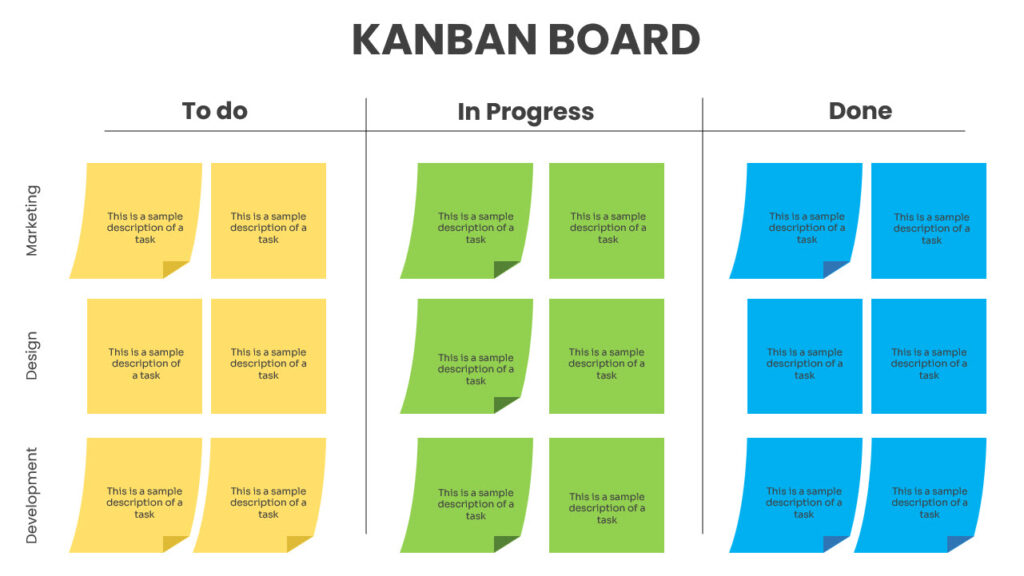Table of Contents
Kanban is an agile methodology used in project management and software development to improve workflow efficiency and optimize team performance. It is based on the principles of lean manufacturing, which was developed by Toyota in the 1940s as a way to reduce waste and improve quality.
Kanban is a visual system that uses a board to visualize and track the progress of work items. This board is divided into columns that represent the different stages of the workflow, and each work item is represented by a card that moves through the board as it progresses.
The term “Kanban” comes from the Japanese word for “billboard” or “signboard”, and it was first used in the context of lean manufacturing to describe the process of signaling the need for more parts or materials as they are consumed.
Kanban was later adapted for software development by David Anderson in the early 2000s. He introduced the concept of limiting work in progress and optimizing flow to reduce bottlenecks and improve cycle time.
Today, Kanban is widely used in various industries, including IT, healthcare, and finance, and is considered a flexible and adaptable approach to project management. It is often used in conjunction with other agile methodologies, such as Scrum or Lean, to optimize team performance and achieve business goals.

Principles of Kanban
The Kanban agile methodology is based on a set of key principles that help to improve workflow efficiency and optimize team performance.
These principles include:
- Visualizing work: emphasizes the importance of visualizing work through the use of a Kanban board. This allows team members to see the progress of work items and identify any bottlenecks or issues that need to be addressed.
- Limiting work in progress: limits the amount of work in progress to ensure that team members are not overloaded and that work is completed promptly. This helps to prevent multitasking and reduce cycle time.
- Managing flow: focuses on optimizing flow through the workflow to ensure that work items move through the system smoothly and quickly. This involves identifying and removing any obstacles or impediments that slow down the flow of work.
- Making process policies explicit: makes process policies explicit so that team members understand how work should be done and what the expectations are for quality and performance.
- Implementing feedback loops: implements feedback loops to allow team members to continuously improve the process and adapt to changing circumstances.
By adhering to these principles, Kanban can help organizations to improve workflow efficiency, reduce waste, and achieve business goals. It provides a flexible and adaptable approach to project management that can be customized to suit the needs of different teams and projects.
Benefits of Kanban
The Kanban agile methodology offers numerous benefits to organizations and teams that implement it.
These benefits include:
- Improved efficiency: helps to improve efficiency by limiting work in progress and optimizing workflow. This leads to faster cycle times and higher productivity.
- Increased transparency: provides a visual representation of the workflow, allowing team members to see the progress of work items and identify any bottlenecks or issues that need to be addressed. This increases transparency and promotes communication and collaboration.
- Enhanced collaboration: promotes collaboration between team members by making the workflow and work items visible to all. This allows team members to work together more effectively and reduce the risk of misunderstandings or miscommunications.
- Reduced waste: helps to reduce waste by optimizing workflow and minimizing the amount of work in progress. This leads to fewer delays, rework, and wasted resources.
- Continuous improvement: emphasizes the importance of continuous improvement through feedback loops and process policies. This allows teams to identify areas for improvement and make incremental changes to the process over time.
Practices of Kanban
The Kanban agile methodology is based on a set of core practices that help teams to improve workflow efficiency and optimize performance.
These practices include:
- Creating a Kanban board: A Kanban board is a visual representation of the workflow that allows team members to see the progress of work items. It typically consists of columns that represent the different stages of the workflow, and cards that represent individual work items.
- Setting work-in-progress limits: Work-in-progress (WIP) limits are used to prevent team members from taking on too much work at once. These limits help to ensure that work is completed promptly and that team members are not overloaded.
- Implementing a pull-based workflow: A pull-based workflow involves only starting work on a new task when there is capacity available to complete it. This helps to prevent multitasking and ensures that work items are completed in the order of priority.
- Managing flow: Kanban focuses on optimizing flow through the workflow to ensure that work items move through the system smoothly and quickly. This involves identifying and removing any obstacles or impediments that slow down the flow of work.
- Implementing feedback loops: Feedback loops are used to allow team members to continuously improve the process and adapt to changing circumstances. This can involve regular retrospectives or reviews to identify areas for improvement.
By implementing these core practices, teams can improve workflow efficiency, reduce waste, and achieve business goals. Kanban provides a flexible and adaptable approach to project management that can be customized to suit the needs of different teams and projects.
Roles and Responsibilities in Kanban
In a Kanban team, there are several key roles, including the Kanban board owner, the service delivery manager, and the service request manager. Each role has specific responsibilities that are essential for the successful adoption of the Kanban methodology.
The Kanban board owner is responsible for the overall design and management of the Kanban board, which serves as the team’s visual representation of work. They ensure that the board accurately reflects the team’s workflow and that it is kept up-to-date with the latest information. Additionally, the Kanban board owner ensures that the team is using the Kanban methodology correctly and that they are following best practices.
The service delivery manager is responsible for the team’s delivery of services or products. They ensure that the team is meeting customer expectations and delivering work on time and within budget. The service delivery manager is also responsible for identifying and resolving any issues or bottlenecks in the team’s workflow, which can help to improve the team’s efficiency.
The service request manager is responsible for managing the team’s incoming requests for work. They ensure that requests are properly prioritized and assigned to the appropriate team members. They also ensure that the team is meeting service level agreements and that work is being delivered on time.
Implementation of Kanban
Implementing Kanban in an organization can be a significant step towards improving productivity, reducing waste, and optimizing workflow.
The following are the steps to implement Kanban in your organization:
- Identify the scope and goals of your Kanban implementation. Define the areas or teams that will use Kanban and the expected outcomes.
- Analyze the current workflow and identify inefficiencies and bottlenecks. Determine the metrics that you will track to measure progress.
- Design the Kanban board. Use columns to represent different stages of work and cards to represent individual tasks.
- Set up work-in-progress limits for each column to prevent overloading.
- Train team members on how to use Kanban effectively, including how to update the board and how identify and to address bottlenecks.
- Monitor progress and continuously improve the process by making adjustments to the Kanban board and workflow as needed.
Common challenges that organizations may face when implementing Kanban include:
- Resistance to change,
- Difficulty in identifying and addressing bottlenecks,
- Maintaining the board’s accuracy and relevance.
To overcome these challenges, it is essential to communicate the benefits of Kanban to team members and involve them in the implementation process. Regular reviews and feedback sessions can help identify and address any issues that arise.
With the proper implementation and continuous improvement, Kanban can help organizations achieve their productivity goals and optimize their workflow.
Kanban Integration with Other Methodologies
Kanban is a flexible methodology that can be easily integrated with other agile methodologies such as Scrum and Lean. By combining Kanban with other methodologies, organizations can benefit from the strengths of each approach and create a more customized agile framework that suits their needs.
When integrating Kanban with Scrum, organizations can use Kanban boards to visualize the flow of work and track the progress of the team. The Kanban board can be used in combination with the Scrum board to provide a more comprehensive view of the team’s work. Additionally, the use of Kanban can help Scrum teams to identify and address bottlenecks in their workflow more efficiently.
Similarly, Kanban can be integrated with Lean to provide a more comprehensive approach to continuous improvement. Lean emphasizes the elimination of waste and the optimization of workflow, while Kanban provides a visual representation of the work and allows teams to track their progress. By using both methodologies together, organizations can identify inefficiencies and continuously improve their processes.
Examples of Kanban
Kanban has been successfully implemented in various industries and contexts, demonstrating its effectiveness in improving workflow and increasing productivity.
Here are some examples of successful implementations:
- Healthcare: A hospital implemented Kanban to manage supplies and organize and standardize supplies while reducing costs and improving the satisfaction of staff and patients.
- Software development: Spotify implemented Kanban in its software development process to optimize workflow and improve team collaboration. The Kanban board allowed the team to track their progress and identify bottlenecks in the workflow, leading to faster and more efficient development.
- Manufacturing: Toyota implemented Kanban in its manufacturing process to optimize production flow and reduce waste. By visualizing the flow of parts and materials, they were able to improve inventory management and reduce production cycle times.
- Education: A high school in New York City implemented Kanban to manage teacher workload and improve student outcomes. By visualizing the teacher’s workload and tracking the progress of assignments, they were able to reduce teacher burnout and improve student engagement.
Tools and Resources
There are many resources available to help organizations and individuals implement Kanban successfully.
Here are some recommended tools and resources:
- Software: There are various Kanban software options available, including Trello, Asana, Jira, LeanKit, and Kanbanize. These tools provide Kanban boards and other features to visualize workflows, track progress, and manage work items.
- Books: There are several books available that guide implementing Kanban, including “Kanban: Successful Evolutionary Change for Your Technology Business” by David J. Anderson, “Kanban from the Inside” by Mike Burrows, and “Personal Kanban: Mapping Work, Navigating Life” by Jim Benson and Tonianne DeMaria Barry.
- Training courses: There are numerous training courses available for individuals and organizations looking to learn and implement Kanban, including those offered by Kanban University, Agile Alliance, and Lean Kanban. These courses cover various aspects of Kanban, such as designing and implementing a Kanban system, using Kanban for Agile transformation, and integrating Kanban with other Agile methodologies.
- Communities and forums: There are several online communities and forums dedicated to Kanban, where individuals and organizations can learn from others’ experiences and get advice on implementing Kanban. Some examples include the Kanban subreddit, the Kanban community on LinkedIn, and the Kanban Zone community.
Future Trends
Kanban has already established itself as a popular and effective methodology for managing workflow and improving productivity in organizations of all types and sizes. Looking into the future, there are several emerging trends and innovations that are likely to shape the future of Kanban and its evolution to meet changing business needs.
One trend is the integration of artificial intelligence and machine learning with Kanban. These technologies can help automate certain aspects of workflow management, such as task assignment and prioritization, allowing teams to focus on higher-level decision-making and strategic planning.
Another trend is the use of Kanban in non-technical industries such as healthcare, education, and manufacturing. As organizations in these industries continue to adopt agile methodologies, Kanban is likely to become a popular choice for managing workflow and improving efficiency.
In terms of innovation, there are already efforts to combine Kanban with other emerging methodologies, such as Design Thinking and Lean Startup. This could help organizations to more effectively manage innovation and product development processes.
Kanban is likely to continue evolving to meet changing business needs and technological advancements. This may involve new features and functionalities in Kanban software, as well as a greater emphasis on collaboration, continuous improvement, and customer-centricity.
Conclusion
Kanban is a powerful methodology that provides organizations with a visual system for managing workflow, optimizing efficiency, and improving productivity. By visualizing the flow of work, identifying bottlenecks, and implementing continuous improvement, Kanban allows teams to focus on delivering high-quality products and services that meet customer needs.
While Kanban was initially developed for use in manufacturing, it has since been adapted for use in various industries and contexts, including software development, healthcare, and education. Its flexibility and adaptability make it a popular choice for organizations seeking to improve their workflow and achieve their productivity goals.
The success of Kanban lies in its ability to facilitate collaboration, transparency, and continuous improvement. By empowering teams to take ownership of their work and providing a clear visual system for managing workflow, Kanban allows organizations to achieve greater efficiency and higher-quality output.
Have you used Kanban? Please share your experience in the comments below.



4 comments
[…] Kanban is a method for managing and improving workflow. It emphasizes visualizing work, limiting work in […]
[…] other Agile methodologies such as Scrum or Kanban, Lean Software Development places a strong emphasis on customer value and minimizing waste. It also […]
[…] Kanban is the most preferred agile framework where the visual flow of the work needs to be shown. It originated from the Japanese “just-in-time” concept developed by Toyota in the 1940s. […]
[…] Kanban is a Lean methodology that emphasizes visualizing work and limiting work in progress. It is less focused on delivering working software and more on improving the efficiency of the development process. In contrast, DSDM places more emphasis on delivering working software, but also emphasizes the importance of continuous improvement. […]
Comments are closed.